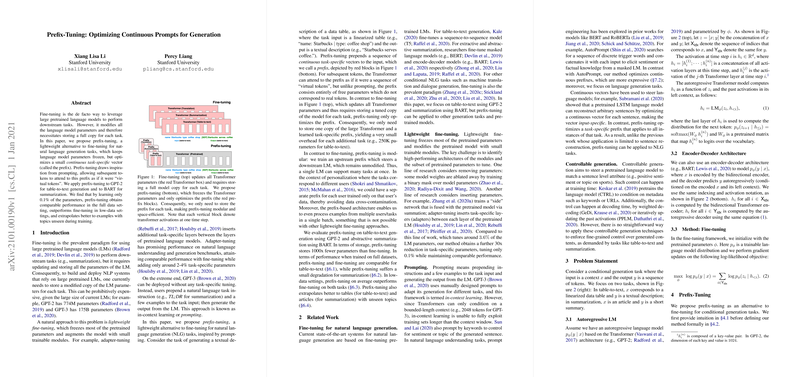A Formal Overview of "Prefix-Tuning: Optimizing Continuous Prompts for Generation"
The paper "Prefix-Tuning: Optimizing Continuous Prompts for Generation" by Xiang Lisa Li and Percy Liang proposes a novel method addressing the limitations of traditional fine-tuning approaches in natural language generation (NLG) tasks. This method, named prefix-tuning, appears to significantly reduce the storage requirements and enhances the efficiency of deploying pretrained LLMs (LMs) for various downstream tasks.
Introduction to the Problem
Fine-tuning is commonly employed to leverage large pretrained LMs, such as GPT-2 and BERT, for downstream NLP tasks, necessitating updates to all model parameters. This approach demands substantial storage as each task requires a modified copy of the LM's parameters, which becomes impractically large given the size of state-of-the-art LMs like GPT-3, with its 175 billion parameters.
Prefix-Tuning: Concept and Mechanics
Prefix-tuning offers a lightweight alternative. Inspired by the concept of prompting, this method keeps the main parameters of the pretrained LM frozen. Instead, it optimizes a small, continuous, task-specific vector, referred to as the prefix. The LM tokens can attend to this prefix as if it were virtual tokens, enabling the model to output task-specific generations without altering the core model. This approach transforms the task-specific adjustments into a modular and space-efficient format.
Results and Evaluations
The authors evaluated prefix-tuning on two primary tasks: table-to-text generation using GPT-2 and abstractive summarization using BART. The results were revealing:
- Efficiency: Prefix-tuning requires optimizing only 0.1% of the parameters compared to full fine-tuning, leading to a storage reduction of 1000x.
- Performance: In settings with full data, prefix-tuning performed comparably to fine-tuning for table-to-text generation and suffered only minor performance degradation in summarization. Additionally, prefix-tuning outperformed fine-tuning in low-data settings.
- Extrapolation: Prefix-tuning demonstrated better generalization on examples with unseen topics, suggesting a robust model adaptation capability without extensive parameter updates.
Numerical Highlights
- Evaluation on Table-to-Text:
- On the E2E dataset, prefix-tuning achieved a BLEU score of 69.7 using GPT-2, outperforming both fine-tuning (68.2) and adapter-tuning (68.9 with 3% task-specific parameters).
- For WebNLG, it recorded significant performance gains in unseen categories, showing superior extrapolation compared to fine-tuning.
- Evaluation on Summarization:
- On the XSUM dataset, prefix-tuning with 2% parameters scored ROUGE-L 36.05 compared to fine-tuning’s ROUGE-L of 37.25.
Analysis of Methodology
The prefix-tuning method preserves the pretrained parameters, leveraging the model's inherent capabilities while adapting to specific tasks via a continuous vector. This enables significant storage savings and allows the model to support multiple tasks without extensive re-training. The authors conducted detailed experiments to validate the effective parameter reduction and its impact on performance.
Methodological Intricacies
- Prefix Length: Performance augmented with increasing prefix length up to a threshold, beyond which slight overfitting was observed.
- Initialization Strategies: Initializing prefixes with real words provided stable and robust performance, essential for the low-data scenarios.
Implications and Future Directions
The practical implications of this research are profound. In real-world applications, where multiple tasks and large-scale deployments are common, prefix-tuning offers a scalable solution. It provides a methodological advancement that accommodates storage constraints while maintaining, or even enhancing, task performance.
Theoretical implications point towards a nuanced understanding of how pretrained models balance generalization and task-specific adaptation when the majority of their parameters remain unchanged. Future research may delve into refining prefix-tuning, exploring variations in prefix structure and further enhancing its extrapolation capabilities.
Speculative Future Developments
- Scalability to Larger Models: Given its success with GPT-2 and BART, prefix-tuning might show enhanced results with even larger models like GPT-3, potentially revolutionizing large-scale NLP task deployments.
- Personalization and Privacy: The proposed method's modular nature suits personalization, allowing independent updates for user-specific prefixes, thereby enhancing privacy.
Conclusion
The methodological advancements presented in this paper represent an incremental yet significant step forward in the optimization of pretrained LLMs for NLG tasks. Prefix-tuning, by selectively updating task-specific vectors, promises efficient adaptation without compromising the model's expansive capabilities. The blend of theoretical rigor and practical efficiency positions prefix-tuning as a valuable tool for the future development and deployment of AI systems in NLP.
